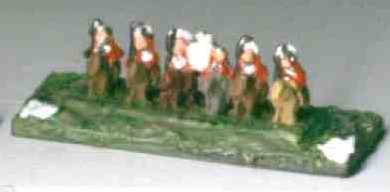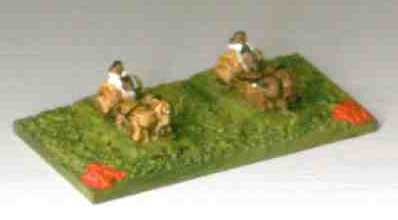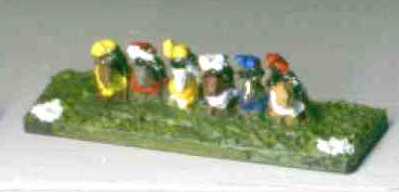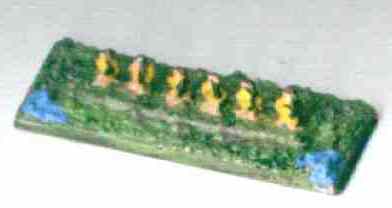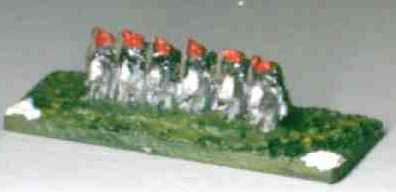|
Atomic Ancients & Miniature Medievals |
|
DBA in 2mm
|
|
|
|
|
|
Danielle Varelli's review of the
Irregular Miniatures 2mm Ancients (on the SoA website) prompted me to re-work a
leaflet that I produced some time ago to support demonstrations
that I did at some shows here in the North of England during the past few years.
Unlike Danielle, I had never seen (and
still haven't) anyone else using 2mm figures (which is quite
surprising as Irregular tell me that they continue to sell very
well). I was fascinated by them; whole armies in the palm of your
hand, 'real' looking bodies of troops instead of a few
representative figures and a tiny storage space needed.
I started with buying a lot of ACW stuff
and a few samples from other ranges, the ACW never came to much
as I got bogged down developing Corps level rules to go with them
but the Ancient/Medieval seemed to offer some scope. I was
beginning to get back into DBA with some 15mm 'Dark Ages' armies
and didn't fancy DBM but a local group were experimenting with a
'big battle' version of DBA and I wanted to try out their ideas (plus
a few of my own) but had nowhere near enough figures. The 2mm
blocks seemed a likely answer so I started thinking .....
|
|
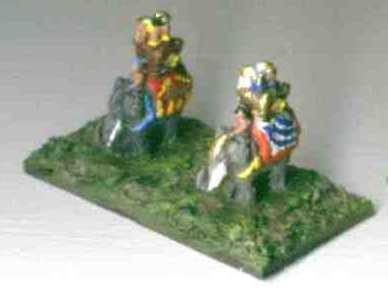
|
|
|
Elephants with Howdahs [ABG21] |
|
|
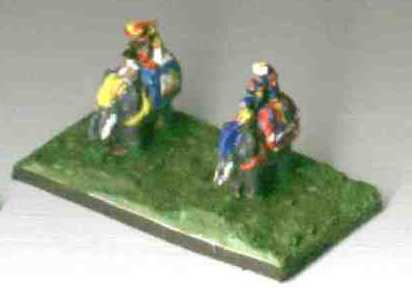
|
|
De Bellis Minisculis |
|
Indian Elephant with crew astride [ABG15]
|
|
The standard base sizes and scales
for 2mm suggested in the DBA rules are 30mm frontage by 10mm depth using
a battlefield the same size (600mm) as for most other sizes. This needs
up to four 2mm blocks (those made by Irregular) per base and requires
cutting many blocks to fit. If we assume that a 2mm block represents a
unit, why not use them as such and use a base size that will fit the
blocks and modify the ground scale and playing area to suit. |
|
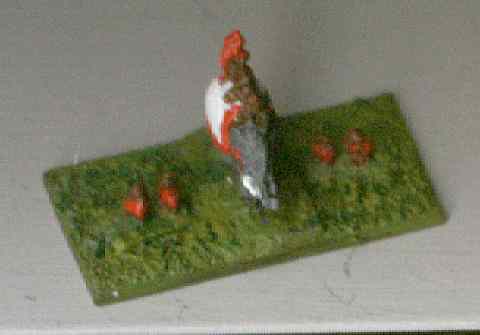
|
|
The
advantages of using this scale are that it is possible to
quickly and cheaply create almost any army and then play
it just about anywhere.
It would be a good scale for
trying out army tactics or effectiveness before buying
and painting a 15mm or 25mm army.
|
|
- Elephant with Light Infantry
|
|
|
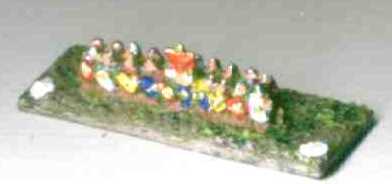
|
|
|
|
ABG1 (above) - Blades - ABG2 (below) |
|
Painting
is fiddly but not too difficult as you only need to
include a minimum of detail and this also makes it
possible to produce generic troop types that will serve
in a large number of different armies. Cavalry in any
army from Akkadian to Albanian looks much the same in 2mm.
You do need reasonably good co-ordination to make
accurate moves so don’t play this with the ‘the
range is 75.5mm so your war engines can’t fire’
types. |
|
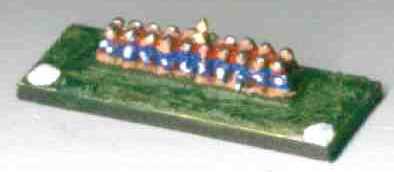 |
|
|
|
|
|
Changes to the DBA rules |
|
|
|
|
|
Auxilia
[ABG13] |
|
Base Frontage : 20mm
|
|
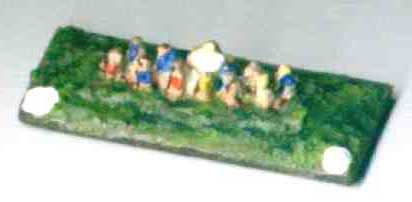 |
|
Base Depth : either all
10mm or 8mm for all but Hordes, Chariots, Elephants, War Wagons
and Artillery which are 10mm
|
|
|
Ground Scale : 15mm =
100paces
|
|
|
Playing Area : between
360mm and 400mm square (14-16 inches)
|
|
|
Camps : 50-60mm wide by
30-40mm deep
|
|
|
|
|
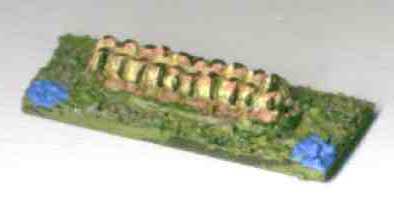 |
|
Rule
Changes
: The only rule change suggested is that all units
consider a base depth to be 10mm wherever this is
mentioned in the rules (e.g. in recoiling). |
|
|
|
|
|
Which blocks do I use ? |
|
Massed
Bows [ABG20] |
|
Listed below are the codes for the
Irregular Miniatures blocks I have found most suited to different
elements. The number in brackets indicates how many to use per
base if more than one. Notice that I have used blocks from the
Renaisance (RBG) and Horse and Musket (BG) ranges as well as the
Ancient (ABG) ones. |
|
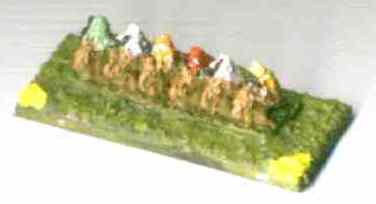 |
|
|
|
Camels
[ABG23] |
|
See
Table of Blocks used for each Element Type |
|
|
|
Basing |
|
|
|
Basing
at such small sizes is best done directly onto a magnetic
base. The thicker type, available in sheets or strips, is
rigid enough once the block has been fixed to it. Using a
magnetic base makes the elements easy to store and carry,
place them in tins or on small boxes lined with steel
paper or thin tinplate. I have nearly 500 DBA elements
stored in a box only 250mm by 270mm and 60mm deep. This
stuff is fairly expensive but it makes the job of basing
and storing such small items so much easier that it is
worth the extra expense. |
|
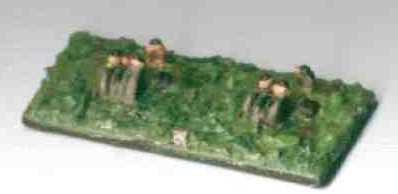 |
|
|
Artillery : Carroballistae
[BG20] |
|
If you
use the self adhesive magnetic strip then cut the
required number of bases to size first. Remove the
backing paper and press the block base firmly onto the
sticky side. If the base doesn’t stick or if you are
putting individual figures on a base I wouldn’t risk
the self-adhesive. Use super glue if there is any doubt
it will stick
|
|
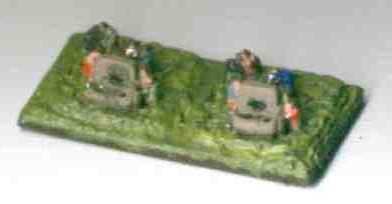 |
|
|
Artillery : Siege Engines
[ABG25] |
|
Put
the textured blocks in a tray and sprinkle fine scatter
or fine, dry sand over the lot. Shake or lightly brush
off of the excess scatter. I find it best to seal this
texturing to the base by overpainting up to the edges of
the block with textured paint that is a bit thinner than
normal. If you use coloured textured paint it also acts
as the base colour and you can finish off the base after
painting by dry-brushing with a darker or lighter shade.
|
|
 |
|
|
Artillery : Bombards
[RBG30] |
|
Don’t
be tempted to try basing too many at once. It is more
fiddly and frustrating than it looks and if you leave the
adhesive too long the scatter doesn’t stick as well. |
|
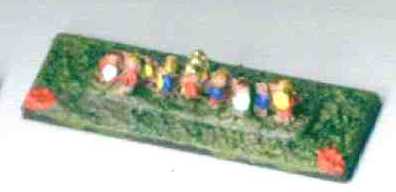 |
|
|
|
|
Painting Tips |
|
|
At the risk of trying to teach my
Grandmother to suck eggs (my 15mm figures never won a painting
competition and nor will my 2mm) the following seem to work
for me. |
|
|
|
|
Warband
[ABG6] |
|
 |
Clean up the blocks and file the
bottom flat so they stick to the base adhesive well. |
 |
Soak for 2 hours in white vinegar,
then rinse in hot water. This helps to remove grease and
moulding additives and the undercoat covers better. (This
helps to solve the problem noted by Danielle of the paint
not penetrating into the detail.) |
 |
Use a dark grey spray undercoat,
Acrylic sold for cars works well. Use it sparingly. I
have tried both white & black too, grey works best. |
 |
Base figures and texture the base (see
above) before painting. |
 |
Use bright and opaque colours and
high contrast if using more than 1 colour. |
 |
Use light flesh where possible, it
shows up better. For darker skinned troops use lighter
coloured clothing against dark flesh colour. |
 |
For Regulars paint clothing all the
same colour and shields all the same. |
 |
For Irregulars use a mixture of
colours, at least on the shields. |
 |
For Barbarians use duller colours
with bright spots or more flesh & bright spots. |
 |
Use Gold for Bronze and Silver for
Iron, they show up better. |
 |
Use brown/black to pick out weapons
with a touch of silver/gold for points & blades. |
 |
Finish with a very much thinned
coat of black, this settles into the hollows to emphasise
detail on some blocks. Experiment to find on which ones
it works for you. |
 |
Paint horses a range of colours if
you want. This is quite possible because most of the
blocks of mounted figures have a small space between the
horses. |
 |
Use a level of detail that suits
you. If you want to paint saddles, shield decoration,
barding on Knights or symbols on the flags then it is
possible with some care and a lot of patience. Do
bear in mind however that you will probably be the only
one that sees it unless you point it out to people. |
|
|
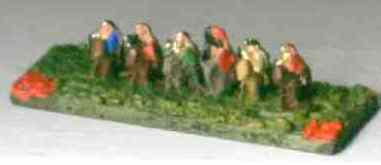 |
|
|
Cavalry
[ABG8] |
|
|
 |
|
|
Cavalry
[ABG4] |
|
|
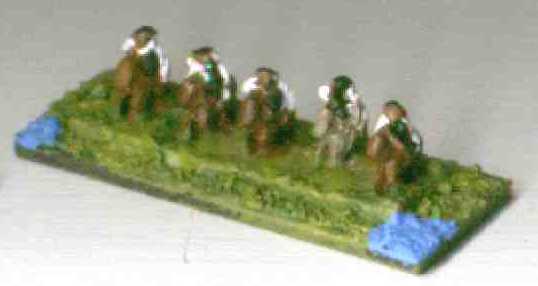 |
|
|
Light
Horse with Bows [ABG9] |
|
|
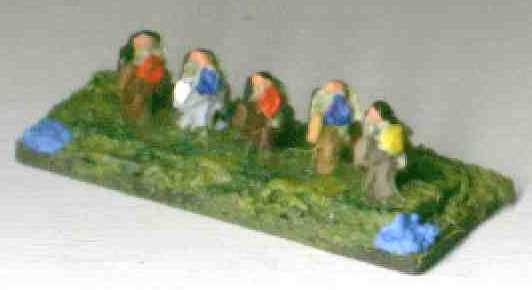 |
|
|
Light
Horse with Javelins [ABG10] |
|
|
|
|
|
General’s
Elements |
|
|
|
In most scales it
is possible to use figures with standards etc. to
indicate a general’s element but 2mm is too small to
do this easily. You could add a large standard of
appropriate type to an element with thin wire, a small
drill and some foil. |
|
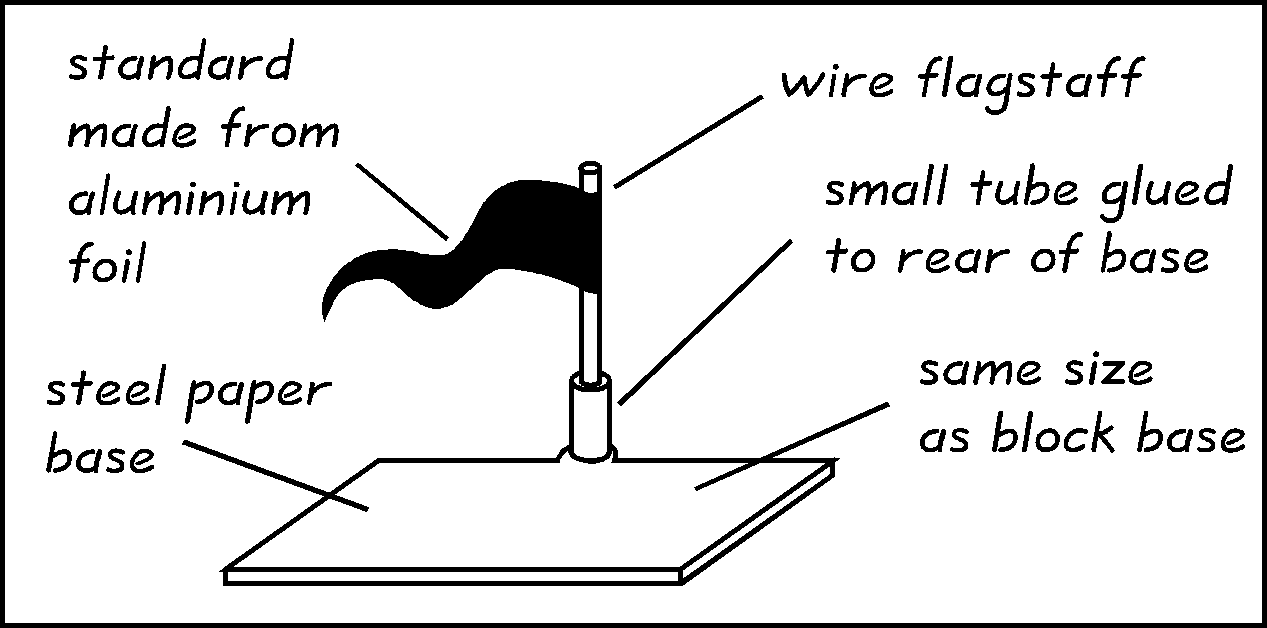
Click
picture to view larger diagram
on a
separate page
Hit the
BACK button to return here |
|
|
|
|
Because my units
are generic (i.e. I don't have Roman, Greek or Hunnic Cv
I just have Cv) I have made separate standards based on
steel paper so that they can go under a based element and
be moved with it. This means any element can be converted
to a general. The diagram shows how this is done. |
|
|
|
|
|
|
Terrain |
|
|
|
You need a fairly smooth surface as a
playing area. I started by using carpet tiles with very little
‘nap’ but I haven’t seen them in the shops for
ages. A cloth or an MDF board given some texture with masonry
paint does just as well.
Terrain features can be bought with the
figure blocks and some are OK. Walls, hedges, bridges and
buildings & settlements are all available but of variable
quality, the woods look good but are too small. The ‘Road
& Tree pack’ paints up very well as either roads or
rivers but needs a lot of preparation as it is poorly cast.
There
is a list of Irregular's 2mm terrain range here
and some scans of them here.
Woods can be carved out of cork tiles,
coated liberally with PVA and then sprinkled with scatter. Fields
of crops can be made by painting thin lines of PVA onto brown
card and sprinkling bright green scatter on them. For bad going
stick a few small stones and tiny bits of moss onto card. Hills
are best made with a smooth surface and less steep than normal as
the bases won’t stay on a steep textured surface, I use 2
layers of 6mm MDF filed and sanded to shape and then painted with
only a bit of texturing.
|
|
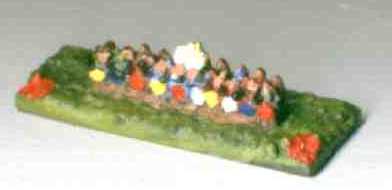 |
|
|
Spears
[ABG18] |
|
|
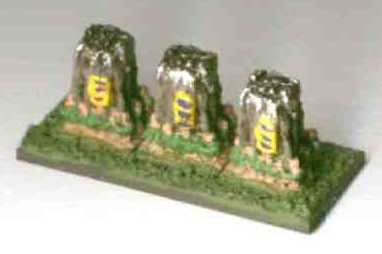 |
|
|
Pikes
[3 * ABG17] |
|
|
|
|
|
Distinguishing
troop types |
|
War
Wagons [RBG31] |
|
Telling one type of element from another
or even which way an element is facing can be difficult during a
battle and so I paint a coloured dot on the two front corners of
the base. The colour is used to distinguish between different
elements with similar appearance (e.g. Sp, Bd & Bw are all
close order foot).
 |
El,
Ar, Pk, WWg & SC don’t
need dots as it is obvious what they are. |
 |
Hd
are the only 2 deep element. |
 |
CF have no dots, they are made
obvious by their position. |
|
|
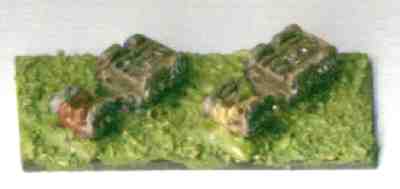 |
| |
|
|
|
|
Green Base
|
CO Inf |
LO Inf |
OO Inf |
Mounted |
Chariots |
Sand/Earth Base |
| Red |
Sp |
Wb |
|
Cv |
LCh |
Red |
|
White |
Bd |
Aux |
|
Kn |
HCh |
Black |
| Yellow |
|
|
|
Cm |
|
Green |
| Light Blue |
Bw |
Cb |
Ps |
LH |
SCh |
Light Blue |
|





















